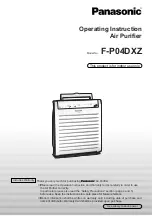
11
SELF-DIAGNOSIS
The appliance has a self diagnosis system to identify a number of malfunctions.
Error messages are displayed on the appliance display.
IF ...
IS DISPLAYED,
“Low Temperature”
(frost prevention)
..WHAT SHOULD I DO?
The appliance is fitted with a frost protec-
tion device to avoid excessive formation of
ice. The appliance starts up again auto-
matically when the defrosting process is
completed.
IF ...
IS DISPLAYED,
Probe Failure
(Probe damaged)
..WHAT SHOULD I DO?
If this is displayed, contact your local au-
thorized service center.
IF ...
IS DISPLAYED,
“High Level”
(Internal tray full)
..WHAT SHOULD I DO?
Empty the internal safety tank following
the instructions in the section “End of
season operations”. If HL alarm reoccurs
frequentely in Air Conditioning, Dehu-
midifying or Heating mode, contact your
local authorized service center.
TIPS FOR CORRECT USE
To ensure optimal results from your air conditioner, follow these
recommendations:
• close the windows and doors in the room to be air condi-
tioned. When installing the air conditioner semi-perma-
nently, you should leave a door slightly open (as little as
1/2 inch (1 cm)) to guarantee proper ventilation.
Close doors and windows
• Never use the appliance in very damp rooms (laundries for
example).
• Protect the room from direct exposure to the sun by par-
tially closing curtains and/or blinds to make the appliance
much more economical to run.
Close blinds or curtains
• Never use the appliance outdoors.
• Make sure there are no heat sources in the room.
• make sure the air conditioner is standing on a level surface.
do not cover the appliance
• Never rest objects of any kind on the air conditioner.
• Never obstruct the air intake or outlet grilles.






























